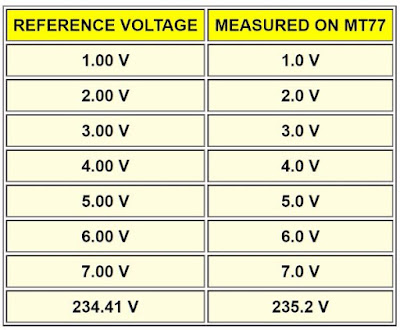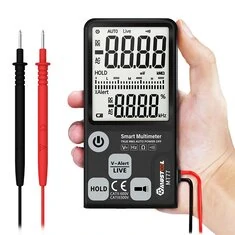Introduction to the Mustool MT77
The delivery of the meter
Mustool's MT77, also known as Bside's ADMS7, comes in a sturdy cardboard box, along with a sixteen page manual in Chinese and English and a carrying strap. The meter is for sale for a price from € 12.00. The most striking feature of this multimeter is its design. With its thickness of only 12 mm, it looks a bit like your smartphone. This impression is confirmed by its very large screen with dimensions of 54 mm by 65 mm. Due to the flat design, it is of course not possible to integrate 4 mm connectors into the case. The two thin test leads are fixed to the meter and come from the right side of the case. These leads have a length of 65 cm and are equipped with thin, yet sturdy looking probes with a sharp point. There is no room for normal batteries. The MT77 works on two 3.0 V lithium button cells, type CR2032. These are mounted in the meter at the time of purchase. So the multimeter is ready to use.
 |
| The Mustool MT77 'smart multimeter' and the packaging in which the meter is delivered. (© 2019 Jos Verstraten) |
In the image below we have summarized the dimensions of this multimeter. This picture also shows all the data that may appear on the display: two digital numerical data and a semi-analogue thermometer scale. The upper numeric scale shows the measured input parameter, the lower one the frequency of the measured AC voltage. At rest, the word 'Auto' appears on this display. The analogue scale is useful if you need to adjust a voltage or resistance to a maximum or minimum value. These turning points are easier to see on an analog scale than on a digital scale.
 |
| The dimensions and display of the MT77. (© 2019 Jos Verstraten) |
The Mustool MT77 is offered by almost all Chinese mail order companies, such as Banggood and AliExpress, with the following measurement ranges specified:
- DC voltage: 60 mV ~ 600 mV ~ 6 V ~ 60 V ~ 600 V ±(0.8 % + 3 digits)
- AC voltage: 60 mV ~ 600 mV ~ 6 V ~ 60 V ~ 600 V ±( 1.2 % + 5 digits)
- Resistor: 0.006 Ω ~ 0.06 Ω ~ 0.6 Ω ~ 6 Ω ~ 60 Ω ~ 600 Ω ~ 6 kΩ ±(1.2 % + 3 digits)
- Frequency: 10 Hz ~ 100 Hz ~ 1 kHz ± (1.0 %+ 5 digits)
The meter works, according to the specifications, 'autoranging' and therefore automatically selects the appropriate measuring range. For DC and AC voltages, these are well usable measuring ranges. We are used to the fact that such a cheap multimeter does not have current ranges. Because currents are not often measured in daily practice, this is not a problem.
The measuring ranges of the resistors are a bit strange. Can such a cheap meter really have a measuring range of 0.006 Ω? And what is the use of this? Why is the highest measuring range only 6 kΩ?

The real measuring ranges
To test the meter, we connected the measuring probes to a reference voltage of 5.000 Vdc. According to the specifications, the measuring range would have to switch on '6 V' and the meter would have to indicate something around '5.000 V'. We were very surprised when the meter only indicated '5.0 V'. Searching through the manual on how to switch on the autoranging resulted in the breathtaking fact that this meter does not have an automatic range changeover at all, but provides only one measurement range for each parameter:
- DC voltage: 600 V with 0.1 V resolution
- AC voltage: 600 V with 0.1 V resolution
- Resistance: 6,000 Ω with 1 Ω resolution
- Frequency: 1,000 Hz with 1 Hz resolution
The specifications on the websites of the suppliers are therefore completely incorrect!
The internal electronics
In the picture below the PCB of the MT77 is shown. What is immediately noticeable is that with the specimen delivered to us, both test leads have been soldered so sloppy on the PCB that they almost touch each other. And bear in mind that, according to the specifications, you can put 600 V between these two leads! The input attenuator consists of six fairly large resistors, so that this circuit can withstand the specified 600 V without problems. In addition to this attenuator, there is a fairly extensive circuit around two ICs of the type A42S. These appear to be double op-amps, similar to the LM158. This circuit is connected to the positive input of the meter via a capacitor and an SMD diode M7. The M7 turns out to be the SMD version of the well-known 1N4007. In the input circuits of both op-amps you will find two transistors that are probably meant as protection.

In the lower left corner is a large white LED chip, which you can switch on with the push button with the flashlight symbol. The usefulness of such a power-hungry facility is not obvious to us, but almost all cheap Chinese multimeters are equipped with such a white LED on the back.
 |
| The internal electronics of the MT77. (© 2019 Jos Verstraten) |
The meter has an automatic continuity mode, which activates the built-in buzzer when the resistance between the inputs is less than 30 Ω. With the button 'V~Alert/LIVE' you can search for conductors in the wall or wires where the live of the mains voltage is present. With the 'HOLD'-key you can freeze the readout.
The Mustool MT77 tested
Measurement of direct voltages
In the table below, we have summarised the measurement results of DC measurements up to 30 V. For some reason, the accuracy is reduced if you measure voltages of more than 10 V. In our example, the switching point between accurate and inaccurate measurement was at 13 V. A reading of 30.5 V at a voltage of 30.00 V results in a fairly large error, namely 1.66 %. It is true that this is within the specifications of ±(0,8 % + 3 digits). The maximum error when measuring 30.00 V should be ±[0.24 V + 3 digits], i.e. the reading should be somewhere between 29.5 V and 30.5 V. So our meter just meets this specification.
 |
| The accuracy in measuring DC voltages. (© 2019 Jos Verstraten) |
We supplied some 50 Hz sinus voltages from our function generator and the mains voltage to the MT77. The results are summarized in the table below. The mains voltage was measured with an error of only 0.33 %. However, the MT77 claimed that the frequency of this voltage was 50.2 Hz, something that according to all our other meters was really not the case.
 |
| The accuracy in measuring AC voltages of 50 Hz. (© 2019 Jos Verstraten) |
In the table below, we have summarised the measurement results by applying a 5.00 Vac voltage with varying frequency to the MT77. Below 30 Hz there was no stable readout, the display blinked so badly that it was even impossible to read the measurement result.
 |
| The frequency range when measuring AC voltages. (© 2019 Jos Verstraten) |
With our resistor bank with an accuracy of ±0,1 % we don't get very far with this meter. After all, with its only range up to 6,000 Ω, only three of our bank's resistors fall within this measuring range. The results are more than disappointing. Our 10 Ω resistor is not recognized and the 100 Ω and 1 kΩ are measured with fairly large errors.
 |
| The accuracy in measuring resistors. (© 2019 Jos Verstraten) |
Our opinion on the Mustool MT77
We have been wondering why a well-known company like Mustool brings such a multimeter on the market and what the target group of this device is. We haven't been able to come up with an answer! The only reason we can think of why you would like to buy an MT77 is that you fall madly in love with the appearance of this meter and out of blind love you decide to buy it.
Reaction of the supplier Banggood
We bought our MT77 at Banggood. Because this company advertises the faulty specifications, we have made this company responsible for delivering a product that does not meet the specifications. Already after one email Banggood was willing to refund the full purchase price, whereby we were allowed to keep the meter. Unfortunately we did not succeed in convincing the people of Banggood that they had to change the specifications of this meter on the website.

Mustool MT77 Large Screen Multimeter

